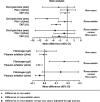Rosuvastatin use increases plasma fibrinolytic potential: a randomised clinical trial
- PMID: 32301122
- PMCID: PMC7539918
- DOI: 10.1111/bjh.16648
Rosuvastatin use increases plasma fibrinolytic potential: a randomised clinical trial
Abstract
We conducted a study to assess the effect of rosuvastatin use on fibrinolysis in patients with previous venous thromboembolism (VTE). This was a post hoc analysis within the STAtins Reduce Thrombophilia (START) study (NCT01613794). Plasma fibrinolytic potential, fibrinogen, plasmin inhibitor, plasminogen activator inhibitor-1 (PAI-1) and thrombin-activatable fibrinolysis inhibitor (TAFI) were measured before and after four weeks of rosuvastatin or no treatment in participants with prior confirmed VTE, after ending anticoagulant therapy. In the non-rosuvastatin group (n = 121), plasma fibrinolytic potential and individual fibrinolysis parameters did not change at the end of the study versus the baseline, whereas in the rosuvastatin group (n = 126), plasma fibrinolytic potential increased: the mean clot lysis time decreased by 8·75 min (95% CI -13·8 to -3·72), and plasmin inhibitor levels and TAFI activity were lower at the end of the study (-0·05 U/ml; 95% CI -0·07 to -0·02 and -4·77%; 95% CI -6·81 to -2·73, respectively). PAI-1 levels did not change and fibrinogen levels were 0·17 g/l (95% CI 0·04-0·29) higher. In participants with prior VTE, rosuvastatin use led to an increased fibrinolytic potential compared with non-statin use. Our findings support the need for further studies on the possible role for statins in the secondary prevention of VTE.
Keywords: HMG-CoA reductase inhibitors; blood coagulation tests; fibrin clot lysis time; fibrinolysis; venous thromboembolism.
© 2020 The Authors. British Journal of Haematology published by British Society for Haematology and John Wiley & Sons Ltd.
Conflict of interest statement
None of the authors reports a conflict of interest with regard to this manuscript.
Figures
References
-
- Kunutsor SK, Seidu S, Khunti K. Statins and primary prevention of venous thromboembolism: a systematic review and meta‐analysis. Lancet Haematol. 2017;4:e83–93. - PubMed
-
- Pignatelli P, Carnevale R, Pastori D, Cangemi R, Napoleone L, Bartimoccia S, et al. Immediate antioxidant and antiplatelet effect of atorvastatin via inhibition of Nox2. Circulation. 2012;126:92–103. - PubMed
-
- Tannous M, Cheung R, Vignini A, Mutus B. Atorvastatin increases ecNOS levels in human platelets of hyperlipidemic subjects. Thromb Haemost. 1999;82:1390–4. - PubMed
Publication types
MeSH terms
Substances
Grants and funding
LinkOut - more resources
Full Text Sources
Other Literature Sources
Miscellaneous


